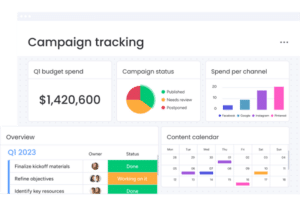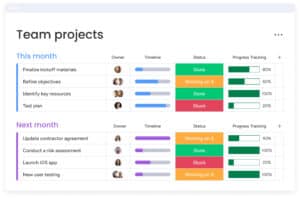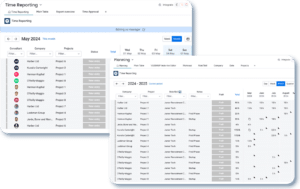In the constantly evolving digital landscape, businesses need to continually adapt and innovate to effectively reach their audience. At the heart of this landscape lies inbound marketing—a customer-centric approach that uses valuable content to attract, engage, and delight potential customers. But just like with any other marketing strategy, managing inbound marketing activities is crucial to optimize performance.
The Importance of Inbound Marketing
Inbound marketing is no longer a novelty—it’s a necessity. As traditional, interruption-based marketing methods continue to lose their efficacy, businesses are turning to inbound marketing to create meaningful relationships with their audience. By providing valuable, relevant content, businesses can attract potential customers, build trust, and ultimately convert these prospects into loyal customers.
The Challenge of Managing Inbound Marketing Activities
However, the beauty of inbound marketing also lies in its complexity. From content creation and SEO to social media and email marketing, inbound activities encompass a broad range of elements. Managing these varied elements and ensuring they work in harmony can often pose a challenge. More so, tracking the performance of these activities, analyzing data, and using these insights to continually improve your strategy can be a daunting task.
In this post, we will delve into best practices for managing and tracking your inbound marketing activities, helping you master the flow of your marketing endeavors. Whether you’re new to inbound marketing or looking to refine your existing strategy, this guide aims to equip you with the knowledge and tools you need to effectively manage your inbound marketing activities.
Understanding Inbound Marketing
Inbound marketing is all about creating value. Instead of the traditional “outbound” marketing methods that focus on reaching out to customers, inbound marketing revolves around the idea of creating valuable content that pulls people towards your brand. But before we delve into how to manage this dynamic process, let’s first take a closer look at what inbound marketing truly entails.
The Inbound Marketing Methodology
The philosophy behind inbound marketing revolves around four stages: Attract, Convert, Close, and Delight. These stages represent the journey of a stranger turning into a visitor, then a lead, a customer, and finally a promoter of your brand.
- Attract: This involves creating and publishing content—blog posts, social media updates, videos, ebooks—that draws in the right people (your buyer persona).
- Convert: Once you’ve attracted website visitors, the next step is to convert those visitors into leads by gathering their contact information. To do this, you need to offer something of value in return like premium content or discounts.
- Close: This stage involves various strategies and tools that help transform those leads into customers, such as CRM systems, email marketing, and sales enablement.
- Delight: Inbound companies continue to engage with, delight, and (hopefully) upsell their current customer base into happy promoters of the products and services they love.
The Components of Inbound Marketing
Inbound marketing involves a variety of components that work together to create a cohesive strategy. These include:
- Content Marketing: Creating and sharing valuable content to attract and convert prospects into customers, and customers into repeat buyers.
- SEO: Ensuring your content is easily discoverable by optimizing it for search engines.
- Social Media Marketing: Engaging with your audience on social media platforms to build your brand, increase sales, and drive website traffic.
- Email Marketing: Sending educational or informative content directly to the people who have expressed interest in your products or services.
- Lead Generation: Capturing the interest of potential customers and turning them into leads for your sales team.
These components aren’t standalone aspects, but rather, integral parts of the inbound marketing machine. And like any machine, inbound marketing works best when all its parts are well-oiled and working together—which is why managing and tracking these activities effectively is paramount. In the following sections, we’ll delve into how to accomplish this.

The Challenges of Inbound Marketing Management
Managing inbound marketing activities is not without its challenges. With so many diverse elements involved in a successful inbound strategy, it can often feel like you’re spinning plates. Let’s discuss some of the key challenges that marketers often face when trying to manage and track inbound marketing activities.
Content Creation and Management
Content is the bedrock of inbound marketing. It’s the medium through which you attract, engage, and delight your audience. But creating consistent, high-quality content that resonates with your target audience can be a daunting task. Moreover, managing this content—knowing what to publish, when to publish it, and which platform to use—requires strategic planning and coordination.
Integrating Diverse Marketing Channels
From your blog and social media platforms to email marketing and SEO, inbound marketing involves a multitude of channels. Each of these channels requires a unique approach, yet they all need to work together to create a cohesive brand message. Integrating these diverse marketing channels and ensuring they’re all aligned with your overall marketing strategy is a common challenge.
Analyzing and Utilizing Data
Data is at the heart of inbound marketing. It’s what allows you to understand your audience, track the performance of your activities, and continually improve your strategy. But with so much data available, it can be difficult to know which metrics to focus on, how to interpret this data, and how to turn these insights into actionable steps.
Time Management
Inbound marketing is a time-intensive strategy. Between creating content, engaging on social media, optimizing for SEO, and analyzing data, there’s a lot to juggle. For many marketers, finding the time to effectively manage all these tasks is one of the biggest challenges.
Keeping Up with Trends and Changes
The digital marketing landscape is always changing. New trends emerge, search algorithms change, and social media platforms update their features. Keeping up with these changes and continually adapting your strategy to stay relevant can be a challenge.
These challenges may seem daunting but fear not—with the right strategies, tools, and practices, you can effectively manage your inbound marketing activities. In the following sections, we’ll dive into these solutions to help you overcome these hurdles and optimize your inbound marketing strategy.
Strategies for Efficient Inbound Marketing Management
Managing inbound marketing activities doesn’t have to be a Herculean task. With the right strategies, tools, and a proactive approach, you can smoothly orchestrate all your marketing efforts. Among the numerous solutions available, monday.com stands out as an exceptional tool for inbound marketing management. Let’s discuss why and delve into some effective strategies for handling your inbound marketing operations.
Embracing Automation
Automation is a fundamental aspect of efficient inbound marketing management. Implementing automation in your processes can take care of repetitive tasks such as scheduling social media posts or email marketing, saving time and ensuring consistency. This is where monday.com shines. It offers robust automation capabilities that can streamline your processes and improve efficiency.
Leveraging Analytics
A strong grasp of your marketing data is essential for effective management of your inbound marketing activities. Understanding your audience interactions, measuring the performance of your campaigns, and gaining insights into your SEO efforts are critical. Here too, monday.com comes into play. Its integrated analytics capabilities allow you to track, analyze, and interpret data all from a single platform.
Consolidating Platforms
One of the major challenges in inbound marketing management is juggling multiple platforms—social media, email, website, content management, etc. An integrated platform like monday.com can serve as a one-stop solution, offering features for managing all these channels. This consolidation makes it easier to align your various marketing activities and maintain a cohesive brand message.
Streamlining Collaboration
Inbound marketing often involves multiple team members—from content creators and SEO specialists to social media managers and data analysts. A platform like monday.com provides a shared workspace where teams can collaborate efficiently, reducing communication mishaps and improving productivity.
Staying Agile and Adaptable
The world of digital marketing is dynamic and fast-paced. Therefore, your inbound marketing management strategy needs to be flexible enough to adapt to changes. With its customizable workflows and adaptable project boards, monday.com allows you to tweak your processes as per evolving marketing trends and business needs.
In the following section, we will delve deeper into the best practices in inbound marketing and how they can further enhance your marketing management strategy when combined with a powerful tool like monday.com.

Best Practices in Inbound Marketing
To further enhance your inbound marketing strategy, it’s crucial to incorporate industry best practices. These are tried and tested methods that have proven effective for many businesses. When combined with efficient management strategies and a versatile tool like monday.com, these practices can greatly optimize your inbound marketing efforts.
Develop a Comprehensive Content Strategy
Content is at the heart of inbound marketing, so it’s essential to have a well-planned content strategy. This should include a content calendar, a clear understanding of your target audience, and a focus on creating high-quality, value-adding content. Use monday.com to schedule and track content creation and publication, ensuring a steady stream of fresh content.
SEO is Key
In the world of inbound marketing, SEO is non-negotiable. Regularly perform keyword research, optimize your website and content for relevant keywords, and ensure your site is mobile-friendly. Also, keep up-to-date with the latest SEO trends and changes in algorithms.
Engage on Social Media
Maintaining an active presence on social media is essential for attracting and engaging with your audience. But remember, it’s not just about promoting your products or services. Aim to provide value, engage in conversations, and build relationships with your audience.
Personalize Your Email Marketing
Email marketing is a powerful tool for nurturing leads and converting them into customers. Personalize your emails as much as possible—use your lead’s name, offer tailored content, and segment your email list to ensure the right messages reach the right people. monday.com can be used to automate and track your email campaigns, increasing efficiency.
Consistently Analyze and Adapt
Remember, inbound marketing is not a set-it-and-forget-it strategy. Constantly analyze your performance, gain insights from your data, and use these insights to adapt and improve your strategy. With monday.com, you can easily track key metrics, generate reports, and make data-driven decisions.
By integrating these best practices with an efficient management tool like monday.com, you can successfully navigate the complexities of inbound marketing and optimize your strategy to its full potential.
Conclusion
Inbound marketing is a potent tool in the modern digital landscape. It allows you to build meaningful connections with your audience, attract potential customers, and convert them into loyal advocates for your brand. However, the effectiveness of this strategy largely depends on your ability to manage and track your inbound marketing activities.
Embracing the Power of Inbound Marketing
As we’ve explored in this guide, managing inbound marketing involves several components—content creation, SEO, social media engagement, email marketing, data analysis, and more. It might seem daunting at first, but with the right strategies, tools, and best practices, it is certainly manageable. By implementing these techniques, you can ensure that your inbound marketing machine operates smoothly and efficiently, continually attracting and delighting your audience.
Harnessing the Power of monday.com
Moreover, platforms like monday.com can greatly simplify the process of managing your inbound marketing activities. By automating tasks, integrating various marketing channels, enabling collaborative work, and providing data analytics, monday.com offers a comprehensive solution for your inbound marketing needs. Are you curious to get started with monday.com? Reach out to us, a world-leading partner of monday.com and we’ll ensure a smooth transition into the platform while handling all implementation and customization for you.
























